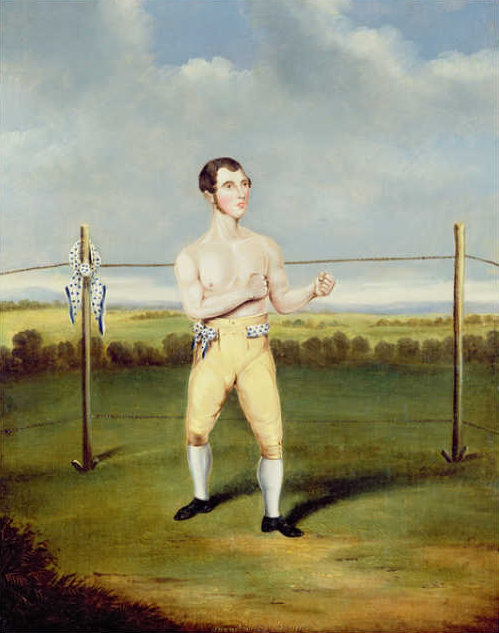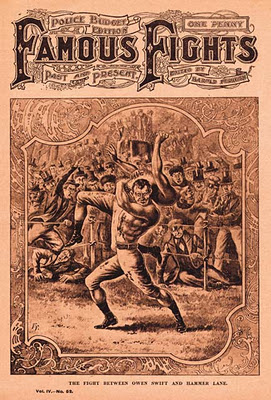Owen Swift on:
[Wikipedia]
[Google]
[Amazon]


 Owen Swift (1814– 9 June 1879) was a British bare-knuckle
Owen Swift (1814– 9 June 1879) was a British bare-knuckle


 Owen Swift (1814– 9 June 1879) was a British bare-knuckle
Owen Swift (1814– 9 June 1879) was a British bare-knuckle prize fighter
Professional boxing, or prizefighting, is regulated, sanctioned boxing. Professional boxing bouts are fought for a purse that is divided between the boxers as determined by contract. Most professional bouts are supervised by a regulatory autho ...
, who killed three men in boxing bouts. The death of "Brighton Bill" in one particularly savage 85-round bout in 1838, and Swift's subsequent conviction for manslaughter
Manslaughter is a common law legal term for homicide considered by law as less culpable than murder. The distinction between murder and manslaughter is sometimes said to have first been made by the ancient Athenian lawmaker Draco in the 7th ...
, led to the adoption of the London Prize Ring Rules
The London Prize Ring Rules were a list of boxing rules promulgated in 1838 and revised in 1853. These rules were based on those drafted by England's Jack Broughton in 1743 (known as the Broughton Rules) and governed the conduct of prizefighti ...
.
Career
His 1 June 1837 fight with Israel "London Izzy" Lazarus (the father ofHarry Lazarus
Harry Lazarus (1839 – January 2, 1865) was an English-born American pugilist, saloon keeper, thief and underworld figure in New York City during the 1850s and early 1860s. He is sometimes confused with his father, famed pugilist Israel ...
) is recounted in detail in Frank Lewis Dowling's 1855 book, ''Fights for the Championship; and Celebrated Prize Battles; Or Accounts of All the Prize Battles for the Championship &c.'' Swift was the outsider, and at odds of 6 to 4, bet on himself to win. Swift was much the lighter man, at no more than nine stone (57 kg; 130 lb) in weight, with "not an ounce of superfluous flesh on his ribs". The odds on both fighters changed many times, and each was "within an ace of losing". The fight lasted 113 rounds, two hours and fifteen minutes, and Lazarus was "dreadfully punished", and it was his last ever fight.
After one of his fights in 1838, which lasted 85 rounds and 95 minutes, Swift's opponent, William Phelps, known as "Brighton Bill", died. The fight took place at Melbourne Heath, Essex, in front of a crowd of about 3,000. Phelps — who had already killed a man — became the third man Swift killed. Bets were taken that neither man would survive for long after the fight; Swift was very badly beaten, making his eventual recovery doubtful.
After the coroner's inquest
A coroner is a government or judicial official who is empowered to conduct or order an inquest into the manner or cause of death, and to investigate or confirm the identity of an unknown person who has been found dead within the coroner's jur ...
, Swift was tried and found guilty of manslaughter, as were three of the organisers. In 1839, ''The Annual Register
''The Annual Register'' (originally subtitled "A View of the History, Politicks and Literature of the Year ...") is a long-established reference work, written and published each year, which records and analyses the year's major events, developmen ...
'' described the fight as "one of the most savage 'pieces of sport' that has disgraced the country for several years".
This event led to the rules of boxing being rewritten. The London Prize Ring Rules
The London Prize Ring Rules were a list of boxing rules promulgated in 1838 and revised in 1853. These rules were based on those drafted by England's Jack Broughton in 1743 (known as the Broughton Rules) and governed the conduct of prizefighti ...
were introduced by the Pugilists's Protective Association and replaced Broughton's rules of 1743. There were 29 rules, built on Broughton's rules, but with more depth and detail. These rules more clearly defined the range of fouls and introduced certain safety measures.
Swift's last two fights were both with Jack Adams, on 5 June and 5 September 1838, both in France. Swift won both fights. Afterwards, Swift became a tavern owner, running the ''Horse Shoe'' in Tichborne Street (now Glasshouse Street), Soho
Soho is an area of the City of Westminster, part of the West End of London. Originally a fashionable district for the aristocracy, it has been one of the main entertainment districts in the capital since the 19th century.
The area was develo ...
, London.
In 1840, Swift published ''The Hand-book to Boxing'', which was a defence of the sport, a history of boxing, a guide for spectators, and advice on how to train and fight.
Death
Swift died in 1879. He is buried atKensal Green Cemetery
Kensal Green Cemetery is a cemetery in the Kensal Green area of Queens Park in the Royal Borough of Kensington and Chelsea in London, England. Inspired by Père Lachaise Cemetery in Paris, it was founded by the barrister George Frederic ...
.
Homonym
Another professional boxer active in 1931–1932, Forest Hall, also used the name Owen Swift.Publications
* * *See also
*Simon Byrne
Simon Byrne (1806 – 2 June 1833), nicknamed "The Emerald Gem", was an Irish bare-knuckle prize fighter. The heavyweight boxing champion of Ireland, he was drawn to England by the larger sums of prize money on offer and his hopes of becomi ...
*Charles Lecour
Charles Lecour (1808 – 1894) was a French boxer. He began his studies of Savate at an early age and was a student of Michel Casseux, who merged Savate and English boxing to a fighting style he eventually called French Boxing.
Life
While sti ...
References
External links
{{DEFAULTSORT:Swift, Owen 1814 births 1879 deaths 19th-century English people Bare-knuckle boxers Burials at Kensal Green Cemetery English male boxers